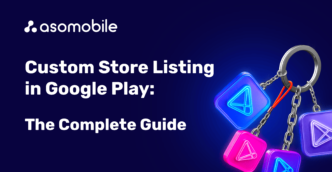Competitor Analysis - Basic Strategies and Tools
Competitor analysis is a topic that needs more attention. This is a necessary process that can significantly impact our application and its success. Competitor analysis is a process that is becoming an essential aspect of development with the development of the mobile application industry. We would all be happy not to do it because we knew our project was unique, but we no longer had such an opportunity. The competition continues to grow, and so does the likelihood that we will develop an existing application. However, there are other reasons to conduct a competitor analysis. The main reason is the opportunity to avoid and learn from competitors' mistakes.
The mobile app industry has reached a point where competition should not be considered an obstacle but a springboard that can help us achieve our goals.
Competitor analysis is the first step in implementing the idea of a mobile app.
You know what is the most unpleasant thing that can happen to developers? Once they have an idea, they start developing and working on it. After putting their heart and soul into it, they release it and... They get comments like, “It's just a bad copy of game X.”
Our first thought when developing our app is to "analyze the market." We can't start working unthinkingly; we need to know:
- The potential of the market we are targeting
- The part of the market we will be able to interact with
- The amount of the market that we will be able to capture.
This is where our Store Comparison or Store insights can help us. This tool comprehensively analyzes the Google Play and App Store mobile app stores.

The main idea when analyzing competitors is to avoid their mistakes. So, instead of following the heroic path of "discoverers," we look at the map to understand where to go and what to watch out for.
Where to start
Where to start analyzing competitors? We will describe the choice of competitors later. Now, let's pretend that we have found the "victims" to investigate, and the main task remains - to take them to pieces to learn the secrets of success. The main thing is not to create more work for ourselves than necessary. There is a specific list of what we are interested in:
- Keywords. Predictably, they are still an integral part of ASO. Knowing the main keywords can make it easier for us to work with them in the future.
- Screenshots and videos. Here, we must analyze how much we enjoy looking at these elements and what attracts attention.
- Reviews and ratings. Why would we need them? Competitor reviews and ratings are the first place we start interacting with our future target audience. Both positive and negative reviews will be essential to us. We recommend focusing on reviews with ratings of 3-4; they are where users put more reasonable criticism and praise.
- Localization. Be sure to check if the app is localized; if yes, it makes sense to review keywords in other languages, too.
Analyze weaknesses and strengths
We're here to make our app better than competitors’, right? So, we need to find the competitors' strengths that we would like to borrow and improve on. There are two places to do these reviews and app descriptions.
- The description is an excellent start to finding the strengths that will stand out.
- Reviews - There are no secrets; we look for good reviews, preferably 4, and try to comprehend what our potential users like.
Weaknesses are just as significant as strengths. We can take even the best of all applications, but users will leave us immediately if we have the same bugs and errors. Weaknesses will be more challenging to work with because everyone has their own opinion on what is wrong. Let's not despair; through some comments, we will understand the big picture and the main weaknesses that bring the most significant inconvenience to users.
We can make a quality app using the knowledge of the strengths and weaknesses. We are here for success, too, to emphasize the most common faults and show that we don't have any. This will help us lure users away from our competitors.
The main factors of competitor analysis for mobile apps
On the one hand, competitor analysis is straightforward. We opened their app page and saw what we were interested in. But before that, we must still choose the right competitors to analyze. Let's have a look at what we need for this.
Using the TOPs is a good strategy for finding competitors. We will often search by category, as this will give us the most matches. Also, once we have selected competitors to analyze, we need to check their chosen main keywords. This can be done using our Spy Competitors tool. We will not only be able to find out the keywords but also compare them with our own.

Analyzing an app page is good, but if the secret of success is not only in the quality of the product, what then?
A simple page analysis will not point us to the success of Duolingo or TikTok. In such cases, we need more. Social networks such as Instagram, Twitter, LinkedIn, etc. can help us with this - messages, tone of voice, target auditory. Their actions there can be directly related to the success we are chasing.
While analyzing our competitors, we must recognize their pricing and monetization strategies. As much as we want to create good apps and bring them to the world, no one can last long without making money.
Common mistakes when analyzing competitors
It is not enough to analyze competitors' mistakes; it is essential not to make new ones. We have found where errors can happen most often.
Goals
We need to know what we are analyzing and looking for. Without a clear goal, it is unlikely that anything will come out, or we will end up with a Frankenstein's monster. We analyze to adjust our development process, not to figure out how to do it.
Is quality better than quantity or not?
Sometimes, it is enough to choose the most successful ones in the top 10, and it will be enough, unfortunately, not in our case. We work with statistical data, and we need a sample without it. The smaller the example, the worse it is in our case. We will learn about fewer errors, valuable features, etc.
The right conclusions
Starting out knowing our goals is excellent. But we also remember conclusions. Why should we analyze if we haven't deduced anything for ourselves? Findings will show us our mistakes and correct our development process. The main thing is to remember that when analyzing, we have approximate figures on our hands, and only the application developers have exact data.
Conclusion
As we can see, competitor analysis is an integral part of the development process. It helps us to understand our application better, define our goals, and make it more successful. It is a specific process in which ASO specialists still work with keywords, screenshots, etc., but look at them from a different angle.
Analyzing can be problematic, especially without understanding competitors' goals and proper selection. Therefore, we will use analytics services to complete everything thoroughly.
 Українська
Українська  Русский
Русский  Español
Español 






